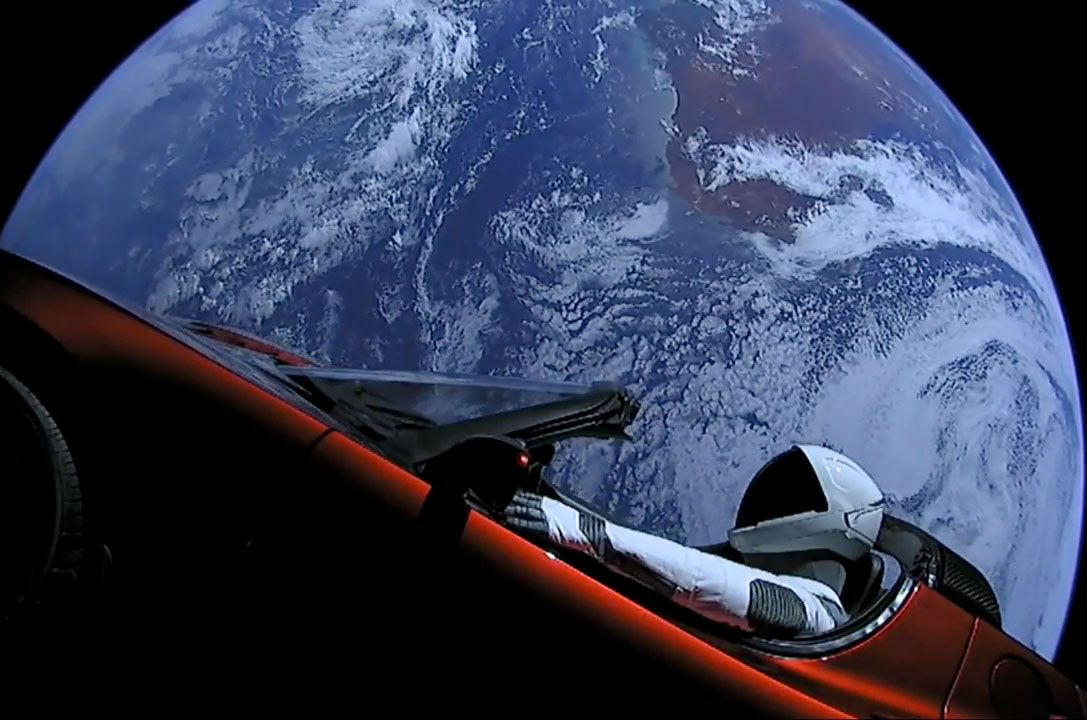On February 6th, 2018, SpaceX successfully launched its Falcon Heavy rocket, the most powerful launch vehicle in their rocket family, and in service today. Not only was this a major milestone for SpaceX, it was also the biggest public relations coup ever orchestrated by Musk. For this launch, Musk decided that the payload would be his cherry Tesla Roadster with a SpaceX spacesuit (affectionately named “Starman”) at the wheel.
Those who watched the live footage of the event (or caught the compilation video released shortly after) are not likely to forget Starman and the Roadster orbiting Earth as David Bowie played in the background. At the time, it was also anticipated that Starman and the Roadster would eventually make a close pass of Mars. Two years after launch, Starman finally accomplished a flyby of the Red Planet!
The Roadster made its first close approach of Mars a week ago, at about 11:25 AM PDT (02:25 PM EDT) on Wednesday, Oct. 7th. According to independent calculations performed by astronomer Jonathon McDowell of the Harvard-Smithsonian Center for Astrophysics (CfA), the Roadster passed within 7.4 million kilometers (4.6 million miles) of Mars. Too far to look down on the surface, but close enough to see Mars’ big red disk.
About an hour later, Musk took to Twitter to share the news. The tweet included the iconic image of Starman riding in Musk’s cherry Roadster and planet Earth in the background with the caption:
“Starman, last seen leaving Earth, made its first close approach with Mars today—within 0.05 astronomical units, or under 5 million miles, of the Red Planet.”
When it comes to launch-testing SpaceX’s rockets, Musk has been known for his interesting choices of cargo. In 2017, when launching a satellite to space aboard a previously-flown Falcon 9 booster (for the first time), Musk included a wheel of cheese as part of the payload. For the inaugural launch of the Falcon Heavy, Musk was looking for something a little more catchy and a lot more inspiring (not that cheese isn’t inspiring, mind you!)
The decision was made that a Tesla Roadster and Starman would be the payload and that David Bowie’s “Space Oddity” would play from the car’s speakers. At the time, Universe Today reported that this seemed like an odd choice since things don’t go so well for Major Tom in Bowie’s famous song. Well, they do in Chris Hadfield cover which he performed while commanding Expedition 35 aboard the ISS, but not in the original!
Nevertheless, the song’s title alone made it appropriate given the curious choice of payload. Also included was a Hot Wheels model of the Roadster with a miniature Starman, copies of the sci-fi novels Foundation by Isaac Asimov and The Hitchhiker’s Guide to the Galaxy by Douglas Adams, and a towel and dashboard sign that said: “Don’t Panic.”
For the commemorative video of the launch, the equally-appropriate Bowie song “Life on Mars” was selected to capture the spirit of the event. At the time, Musk took to Twitter to explain the choice of using his Roadster and Starman for the launch, saying:
“Why Falcon Heavy & Starman? Life cannot just be about solving one sad problem after another. There need to be things that inspire you, that make you glad to wake up in the morning and be part of humanity. That is why we did it. We did for you.”
Musk’s original flight plan called for the Roadster to achieve a Hohmann Transfer Orbit that would place it in a circular orbit around Mars, where it would remain for up to a billion years. Unfortunately, the mission overshot and the second stage of the Falcon Heavy and Roadster ended up in a 557-day elliptical orbit that will take it far beyond Mars’ orbit and out toward the Asteroid Belt.
This is not the first time that the car’s path has crossed Mars’ orbit, but it is the first time it has made a close flyby of Mars itself. Since no communication with the second stage or Roadster is possible, McDowell had to make these orbital calculations using the last available mission data, as well as gravitational data used by NASA. As he said in an interview with Business Insider:
“It’s a pretty confident extrapolation, because we understand gravity pretty well. The only thing that could throw you off is what we call outgassing: If there was leftover fuel, or if the paint job on the Tesla carriage came off, that acts as a little rocket that pushes it forward. But that won’t change it much.”
What’s next for Starman and his cherry ride? At present, they are expected to make a close flyby of Earth on November 5th, passing within 52 million km (32 million mi) of our planet. According to previous calculations performed by astronomers from the University of Toronto and Charles University’s Institute of Astronomy, it’s likely that Starman and the Roadster will eventually collide with Earth (or Venus or the Sun).
Luckily, that won’t be for ten million years or so. This means Musk’s curious payload will be on an extended tour of the Solar System for eons to come, possibly even long after humanity is gone. At least that way, extraterrestrials will have proof that we existed, and that some of us had brains and a quirky sense of humor!
In the meantime, check out this SpaceX animation of Starman and the Roadster flying to Mars, and stay tuned for more updates on Starman’s tour!
Further Reading: Business Insider, Twitter

